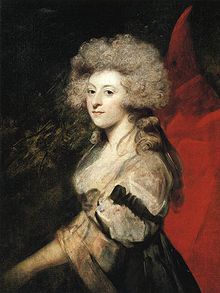Maria Fitzherbert
| Maria Fitzherbert | |
|---|---|

Portrait by Sir Joshua Reynolds
|
|
| Born |
Maria Anne Smythe 26 July 1756 Tong, Shropshire |
| Died | 27 March 1837 (aged 80) Steine House, Brighton |
| Resting place | St John the Baptist's Church, Kemp Town, Brighton |
| Spouse(s) | Edward Weld Thomas Fitzherbert George IV of the United Kingdom |
| Parent(s) | William Smythe Mary Ann Errington |
Maria Anne Fitzherbert (née Smythe, previously Weld; 26 July 1756 – 27 March 1837) was a longtime companion of the future King George IV of the United Kingdom with whom she secretly contracted a marriage that was invalid under English civil law before his accession to the throne. Though Fitzherbert had been disinherited by her first husband, her nephew-in-law (Cardinal Weld) persuaded Pope Pius VII to declare the marriage sacramentally valid.
Fitzherbert was born at Tong, Shropshire. She was the eldest child of Walter Smythe of Brambridge, Hampshire, younger son of Sir John Smythe, 3rd Baronet, of Acton Burnell, Shropshire. Her mother was Mary Ann Errington of Beaufront, Northumberland, maternal half-sister of Charles William Molyneux, 1st Earl of Sefton. She was educated in Paris at a French convent.
Fitzherbert married Edward Weld, 16 years her senior, a rich Catholic landowner of Lulworth Castle in July 1775. Weld died just three months later after a fall from his horse and having failed to sign his new will. His estate went to his younger brother Thomas, father of Cardinal Weld. His widow was left effectively destitute, had little or no financial support from the Weld family and was obliged to remarry as soon as she could.
She married a second time, three years later, to Thomas Fitzherbert of Swynnerton, Staffordshire. She was ten years younger than he. They had a son who died young. She was widowed again on 7 May 1781. He left her an annuity of £1000 and a town house in Park Street, Mayfair.
The twice widowed Fitzherbert soon entered London high society. In spring, 1784, she was introduced to a youthful admirer: George, Prince of Wales, six years her junior. The prince became infatuated with her and pursued her endlessly until she agreed to marry him. Secretly, and – as both parties were well aware – against the law, they went through a form of marriage on 15 December 1785, in the drawing room of her house in Park Street, London. Her uncle, Henry Errington, and her brother, Jack Smythe, were the witnesses. This invalid marriage ceremony was performed by one of the prince's Chaplains in Ordinary, the Reverend Robert Burt, whose debts (of £500) were paid by the prince to release him from the Fleet Prison.
...
Wikipedia
